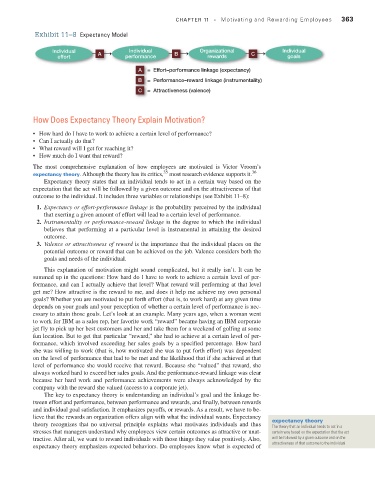Page 364 - Fundamentals of Management Myths Debunked (2017)_Flat
P. 364
Exhibit 11–8 Expectancy Model CHAPTER 11 • Motivating and Rewarding Employees 363
Individual Individual Organizational Individual
e ort A performance B rewards C goals
A = E ort–performance linkage (expectancy)
B = Performance–reward linkage (instrumentality)
C = Attractiveness (valence)
How Does Expectancy Theory Explain Motivation?
• How hard do I have to work to achieve a certain level of performance?
• Can I actually do that?
• What reward will I get for reaching it?
• How much do I want that reward?
The most comprehensive explanation of how employees are motivated is Victor Vroom’s
35
expectancy theory. Although the theory has its critics, most research evidence supports it. 36
Expectancy theory states that an individual tends to act in a certain way based on the
expectation that the act will be followed by a given outcome and on the attractiveness of that
outcome to the individual. It includes three variables or relationships (see Exhibit 11–8):
1. Expectancy or effort-performance linkage is the probability perceived by the individual
that exerting a given amount of effort will lead to a certain level of performance.
2. Instrumentality or performance-reward linkage is the degree to which the individual
believes that performing at a particular level is instrumental in attaining the desired
outcome.
3. Valence or attractiveness of reward is the importance that the individual places on the
potential outcome or reward that can be achieved on the job. Valence considers both the
goals and needs of the individual.
This explanation of motivation might sound complicated, but it really isn’t. It can be
summed up in the questions: How hard do I have to work to achieve a certain level of per-
formance, and can I actually achieve that level? What reward will performing at that level
get me? How attractive is the reward to me, and does it help me achieve my own personal
goals? Whether you are motivated to put forth effort (that is, to work hard) at any given time
depends on your goals and your perception of whether a certain level of performance is nec-
essary to attain those goals. Let’s look at an example. Many years ago, when a woman went
to work for IBM as a sales rep, her favorite work “reward” became having an IBM corporate
jet fly to pick up her best customers and her and take them for a weekend of golfing at some
fun location. But to get that particular “reward,” she had to achieve at a certain level of per-
formance, which involved exceeding her sales goals by a specified percentage. How hard
she was willing to work (that is, how motivated she was to put forth effort) was dependent
on the level of performance that had to be met and the likelihood that if she achieved at that
level of performance she would receive that reward. Because she “valued” that reward, she
always worked hard to exceed her sales goals. And the performance-reward linkage was clear
because her hard work and performance achievements were always acknowledged by the
company with the reward she valued (access to a corporate jet).
The key to expectancy theory is understanding an individual’s goal and the linkage be-
tween effort and performance, between performance and rewards, and finally, between rewards
and individual goal satisfaction. It emphasizes payoffs, or rewards. As a result, we have to be-
lieve that the rewards an organization offers align with what the individual wants. Expectancy
theory recognizes that no universal principle explains what motivates individuals and thus expectancy theory
The theory that an individual tends to act in a
stresses that managers understand why employees view certain outcomes as attractive or unat- certain way based on the expectation that the act
tractive. After all, we want to reward individuals with those things they value positively. Also, will be followed by a given outcome and on the
expectancy theory emphasizes expected behaviors. Do employees know what is expected of attractiveness of that outcome to the individual

